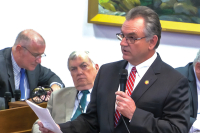Former NYPD detective provides crisis training for cops
 Det. Sgt. Ron Martin.
Det. Sgt. Ron Martin.
Det. Sgt. Ron Martin often uses a popular Star Trek anecdote to make a point about making difficult changes when the current ways aren’t netting the best results.
When Starfleet Academy cadet James Kirk did the Kobayashi Maru training exercise — one that is considered a “no-win scenario” test — he failed the first two times. But the third time, he did what no one else had thought to do; he reprogrammed the test simulator so he could meet the challenge without having to face the consequences. It was essentially cheating, but in the end he was the first person to beat the test and was commended for “original thinking” that saved the civilian vessel from the Klingons.
It probably didn’t seem like the right or the popular thing to do, but the soon-to-be Capt. Kirk did it anyway and turned a certain loss into a win-win situation. That’s what needs to happen within the criminal justice system, Martin said.
“If we want a different result, we have to do things differently,” he said.
Martin has more than 20 years of experience as a law enforcement officer, including his time working for the New York Police Department. At the NYPD, he trained officers to a highly proficient level of community patrol, enforcement and public security. He supervised narcotics teams conducting street level buy and sell operations and warrant executions, and managed mid- to high-level narcotic cases involving pen wires leading to extensive criminal prosecution. He also consulted directly with the chief of police and the mayor of New York City on issues of internal misconduct and worked as a narcotics supervisor for the last three years with the department. Martin said something shifted after Sept. 11, 2001. As New York City and the rest of the nation tried collectively to pick up the pieces, priorities among law enforcement and other first responders in the city had to change. He said it became clear to him that policing practices also needed to change in response to that change.
“I had an epiphany I guess, that there needed to be a better balance between living and dying,” he said. “We needed to reprioritize who we arrest and ask ourselves what’s more important than the value of lives.”
Related Items
Knowing his expertise in law enforcement and also his willingness to re-evaluate how law enforcement reacts to issues of addiction and homelessness, Martin said his wife put his name forward to someone working to ramp up harm reduction programs in North Carolina.
While the North Carolina Harm Reduction Coalition was already up and running with programs happening in the more urban areas, Martin could bring more credibility to convincing others of the positive outcomes of these programs, especially Crisis Intervention Team (CIT) training for fellow law enforcement.
“My voice in the matter is just heard differently. Some (harm reduction advocates) may get push back from first responders and law enforcement officers but it’s easier coming from me,” he said.
That’s been true in Haywood County lately. Even though Haywood is one of a few counties in the state with full-time harm reduction boots on the ground, these advocates have been unable to convince some residents and a couple of county leaders of the benefits of programs, with the syringe program being the most controversial.
After many months of discussion and debate over the effectiveness of harm-reduction measures — including impassioned pleas from NCHRC representatives Jesse-Lee Dunlap and Becca Goldstein — Haywood County commissioners finally voted to extend its contract with the coalition for another six months. However, Republican Commissioners Brandon Rogers and Mark Pless (who is running for state representative) voted against it. Through this contract to utilize federal grant money, the coalition works to link people to resources for substance use disorder and temporary housing.
Martin admits it can be a hard sell because people think providing clean needles to addicts is enabling them to use, creating more dirty needle pollution in the community and leading to more crime, even though the data shows otherwise. But if he can get in front of a room of law enforcement and share his experiences, it can bring about a greater opportunity for police buy-in when it comes to using harm reduction models.
“Some of that comes from me selling myself and being credible, but also it has to do with common sense and getting them to understand the consequences of what we do,” Martin said. “When you arrest someone at the scene there’s a ripple effect throughout the entire community.”
It’s understandable for officers to focus solely on their obligation to enforce the laws, but Martin said he tries to get LEOs to think more about the impact of an arrest after the person is booked. He wants them to question the outcomes — if I arrest this woman for drug possession, what happens to her kids? If I arrest this man for loitering because he’s homeless, who does that benefit?
Sometimes arresting a person is in the best interest of the community, especially if they are a danger to themselves or others or they committed a violent crime. On the other hand, an arrest can make a bad situation worse for everyone involved and doesn’t do anything to enhance the safety of the community. The most important point Martin makes to officers is that something has to change if they want something to change. If communities want better outcomes, society has to change the processes.
“The whole buy-in comes from any paradigm changing and that just comes with time,” he said.
Harm reduction has made major headway in North Carolina from 2012 through 2019, but then 2020 came with some unexpected challenges. With COVID-19 and a resurgence of civil/racial unrest, law enforcement has had to adapt to the best of its ability. Trying to limit public interactions and keep the virus from spreading in the jails, certain types of arrests have decreased and jail populations are down to manageable numbers because officers are being more mindful about who they arrest and judges are being more mindful about who stays in jail. These are both positive steps from a harm reduction standpoint.
As far as Black Lives Matters protesters taking to the streets, looters destroying property, rioters tearing down Confederate monuments and counter-protesters murdering innocent protesters, well all that puts a bad taste in law enforcement’s mouth.
“Now cops are thinking, ‘the public has declared war against us, why am I gonna save anyone’s life?’ At the same time we’re seeing a spike in overdoses and it’s more problematic than it was before,” Martin said. “I think some things will revert back to how they were before and some will be new changes we move forward with.”
He is not a believer in “defunding” the police, but he is a proponent of police reform because he understands that “bad policing” is a problem. He wants to see a greater sense of professionalism return to agencies.
“Having a knee on someone’s neck is bad policing and not calling it out is defending it,” Martin said. “I want to teach officers about all the mini-judgments they make that get them to that point. The number one police power will be discretion and that will mean the difference between liberty and incarceration for people.”
CIT training is educating first responders to think through the discretion they have and using their power in a way that is for the greater good of the community — that’s at the heart of community patrolling. This is what Martin teaches to more than a thousand officers a year through his part-time position with the North Carolina Harm Reduction Coalition. He also serves on the board of directors. The harm reduction model is something he’s passionate about and something he gravitated toward because of his experience in law enforcement.
While he finds himself more on the advocate side of the fence these days, he understands it’s a fine line to walk on both sides. As former law enforcement, he sees how some harm reduction advocates tend to have “all or nothing” thinking. They want all the change to happen immediately and the change to happen in a certain way, but that’s not how progress occurs. It’s more like a pendulum that swings back and forth before finding balance in the middle.
“CIT would be a tremendous benefit to any agency. I’ve watched police departments be transformed,” Martin said. “The bottom line is how they incorporate themselves in the community and that they have the ability to do things differently, but they need to know they’re supported if they try stepping out of the norms.”
What is CIT Training?
The lack of mental health crisis services across the U.S. has resulted in law enforcement officers serving as first responders to most crises. A Crisis Intervention Team (CIT) program is an innovative, community-based approach to improve the outcomes of these encounters. CIT programs:
• Give police officers more tools to do their job safely and effectively. Research shows that CIT is associated with improved officer attitude and knowledge about mental illness.
• Keep law enforcement’s focus on crime. Some communities have found that CIT has reduced the time officers spend responding to a mental health call. This puts officers back into the community more quickly.
• Produce cost savings. It’s difficult to estimate exactly how much diversion programs can save communities, but incarceration is costly compared to community-based treatment.
For more information, visit www.nami.org.









